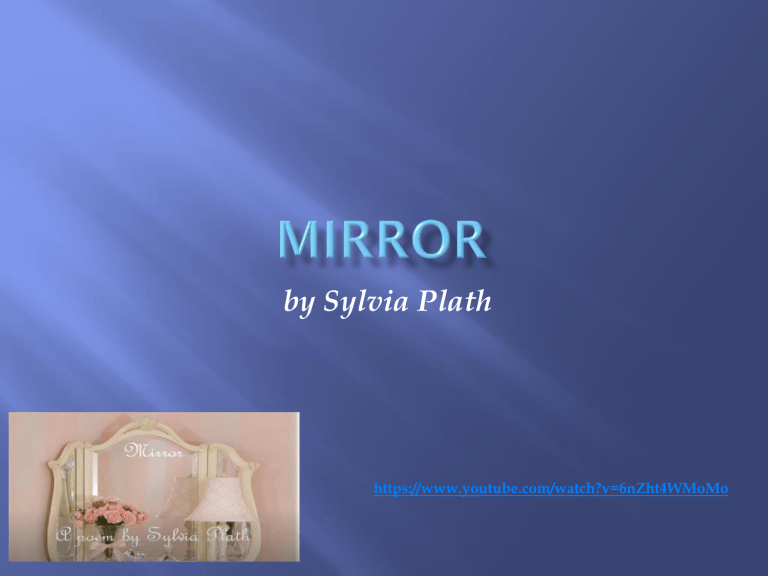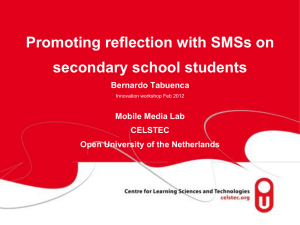
by Sylvia Plath https://www.youtube.com/watch?v=6nZht4WMoMo The title immediately tells us what the subject of the poem is. The mirror is personified throughout the poem and speaks directly to us, using the personal pronoun ‘I’. Mirror is written in free verse form, meaning that there is no repeated pattern of rhyme or rhythm. Plath does make use of half-rhymes throughout to create emphasis. Half-rhyme is the term used to refer to words that nearly rhyme, but not quite. In the first stanza, the mirror describes itself both in appearance and character: the mirror is a truth-teller, reflecting what is really there, but not cruel in any way. In the second stanza, there is a sudden shift as the mirror turns into a lake that provides reflections, and the character of the woman is introduced. The woman is upset by her own reflection and tries to change it, but the truth will not be hidden: she is no longer the young woman she once was. Synopsis is a brief summary I am silver and exact. I have no preconceptions. Whatever I see I swallow immediately Just as it is, unmisted by love or dislike. I am not cruel, only truthful The eye of a little god, four-cornered. The mirror claims that it replicates and reflects exactly what it sees – a true image of what is directly in front of it. The image is not altered or obscured by emotion or bias; there is no ulterior motive or agenda. The rectangular / square ‘little god’ is an objective but powerful entity that sees everything in front of it. Most of the time I meditate on the opposite wall. It is pink, with speckles. I have looked at it so long I think it is part of my heart. But it flickers. Faces and darkness separate us over and over. Even though the mirror is all-seeing and powerful, it mostly reflects ‘the opposite wall’. The ‘pink’ wall suggests that it is hanging in a girl’s bedroom. The mirror has spent so long looking at the wall that it has become part of its very identity or soul. (Remember the mirror is personified). The wall is obscured when a person comes between them; when the lights are turned off; or at night. Now I am a lake. A woman bends over me, Searching my reaches for what she really is. Then she turns to those liars, the candles or the moon. I see her back, and reflect it faithfully. The second stanza shows an abrupt shift – from a mirror to ‘a lake’, which the woman bends over searching for her reflection. She is not just searching for a reflection of her physical appearance, but for a reflection of ‘what she really is’ – her identity, her soul, the meaning of her existence. However, she doesn’t like what she sees so she turns to candles and the moon to provide a different light in which she can see herself. Candles and moonlight provide softer, more flattering light. The lake, however, will not be fooled, and it reflects faithfully and truthfully. She rewards me with tears and an agitation of hands. I am important to her. She comes and goes. Each morning it is her face that replaces the darkness. The woman is upset by what she sees , reacting with ‘tears of anguish’ and wringing her hands in ‘agitation’. However, she continues to return to the lake to look at her reflection, which is important to her. She is at the lake first thing every morning to gaze at her reflection in the water. In me she has drowned a young girl, and in me an old woman Rises toward her day after day, like a terrible fish. The young girl who the woman once saw reflected back at her has disappeared – as though drowned in the waters of the lake. Every day, the ‘old woman’ she will become is appearing more clearly to her as she ages in her reflection. Just as the mirror in the first stanza, the reflection provided by the lake is truthful: she is no longer a young woman. The image of a grotesque fish also reflects what the woman sees as the hideous appearance of her reflection as she ages. Mirror can be seen as a symbol for poetry, or for Plath herself. The similarity of ‘silver’ and the poet’s name Sylvia represents Plath’s meditation on her craft: as a poet she reflects the world around her truthfully – as she sees it. She aims to be objective rather than ‘cruel’. For most of the time, she reflects on the ‘opposite wall’ which represents her ‘heart’ or identity. This identity ‘flickers’ or is obscured by the interference of external elements such as people. Another interpretation is that the poem is concerned with the theme of change and the passage of time. This is evident in the second stanza where the woman becomes distressed because her appearance changes as each day passes. The theme is further extended to include the anxiety women feel regarding their aging and appearance and the distress caused by pressure from society to look a certain way. An intertextual reference is when another poem, story or text is alluded to in the poem. The second stanza gives us an intertextual reference. The woman is gazing at her reflection in the water of the lake. This refers to the story of Narcissus from Greek mythology. Narcissus was a hunter who was well-known for his good looks. He was also extremely vain. He fell in love with his own reflection when he saw it in a pool of water. He became so obsessed with his own image that he could not leave it, and spent so long gazing at it that he eventually died. (Some versions of this myth say that he leaned forward to kiss his reflection, fell into the water and drowned.) This myth is the origin of the term ‘narcissist’ which we use to describe someone who is extremely vain and obsessed with themselves.

